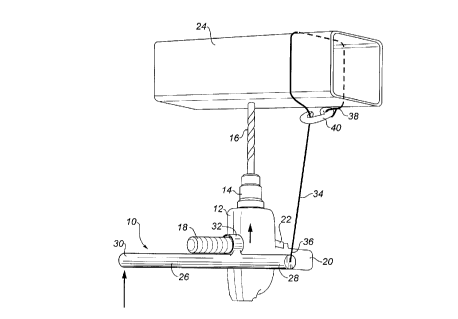Some of the information on this Web page has been provided by external sources. The Government of Canada is not responsible for the accuracy, reliability or currency of the information supplied by external sources. Users wishing to rely upon this information should consult directly with the source of the information. Content provided by external sources is not subject to official languages, privacy and accessibility requirements.
Any discrepancies in the text and image of the Claims and Abstract are due to differing posting times. Text of the Claims and Abstract are posted:
| (12) Patent: | (11) CA 2173424 |
|---|---|
| (54) English Title: | APPARATUS FOR INCREASING HAND DRILL PRESSURE |
| (54) French Title: | DISPOSITIF POUR AUGMENTER LA PRESSION DANS UNE PERCEUSE MANUELLE |
| Status: | Deemed expired |
| (51) International Patent Classification (IPC): |
|
|---|---|
| (72) Inventors : |
|
| (73) Owners : |
|
| (71) Applicants : |
|
| (74) Agent: | WOODRUFF, NATHAN V. |
| (74) Associate agent: | |
| (45) Issued: | 2000-05-16 |
| (22) Filed Date: | 1996-04-03 |
| (41) Open to Public Inspection: | 1997-10-04 |
| Examination requested: | 1998-03-27 |
| Availability of licence: | N/A |
| (25) Language of filing: | English |
| Patent Cooperation Treaty (PCT): | No |
|---|
| (30) Application Priority Data: | None |
|---|
An apparatus for increasing hand drill pressure includes
a lever having a first end and a second end. A sleeve is
affixed transversely to the lever spaced from the first end.
An anchor line is provided having a first end and a second end.
The first end of the anchor line is secured to the first end
of the lever. A hook is provided on the second end of the
anchor line. The sleeve slides over a handle of a hand drill.
The hook is used to anchor the anchor line to a workpiece.
The lever provides a mechanical advantage to increase the
pressure with which the hand drill engages the workpiece.
Appareil pour accroître la pression d'une perceuse à main comprenant un levier muni d'une première et d'une deuxième extrémité. Un manchon, fixé transversalement sur le levier, à une certaine distance de la première extrémité, est conçu pour être glissé sur le manche d'une perceuse à main. Un fil d'ancrage est doté d'une première et d'une deuxième extrémité, la première est fixée sur la première extrémité du levier et la deuxième est équipée d'un crochet destiné à ancrer la corde d'ancrage à une pièce à travailler. Le levier fournit un gain mécanique, ce qui permet d'accroître la pression de la perceuse à main sur la pièce à travailler.
Note: Claims are shown in the official language in which they were submitted.
Note: Descriptions are shown in the official language in which they were submitted.

For a clearer understanding of the status of the application/patent presented on this page, the site Disclaimer , as well as the definitions for Patent , Administrative Status , Maintenance Fee and Payment History should be consulted.
| Title | Date |
|---|---|
| Forecasted Issue Date | 2000-05-16 |
| (22) Filed | 1996-04-03 |
| (41) Open to Public Inspection | 1997-10-04 |
| Examination Requested | 1998-03-27 |
| (45) Issued | 2000-05-16 |
| Deemed Expired | 2013-04-03 |
There is no abandonment history.
| Fee Type | Anniversary Year | Due Date | Amount Paid | Paid Date |
|---|---|---|---|---|
| Application Fee | $0.00 | 1996-04-03 | ||
| Request for Examination | $200.00 | 1998-03-27 | ||
| Maintenance Fee - Application - New Act | 2 | 1998-04-03 | $50.00 | 1998-03-27 |
| Maintenance Fee - Application - New Act | 3 | 1999-04-05 | $50.00 | 1999-03-16 |
| Final Fee | $150.00 | 2000-02-16 | ||
| Maintenance Fee - Application - New Act | 4 | 2000-04-03 | $50.00 | 2000-02-16 |
| Maintenance Fee - Patent - New Act | 5 | 2001-04-03 | $75.00 | 2001-03-21 |
| Maintenance Fee - Patent - New Act | 6 | 2002-04-03 | $75.00 | 2002-03-22 |
| Maintenance Fee - Patent - New Act | 7 | 2003-04-03 | $75.00 | 2003-03-31 |
| Maintenance Fee - Patent - New Act | 8 | 2004-04-05 | $100.00 | 2004-03-11 |
| Maintenance Fee - Patent - New Act | 9 | 2005-04-04 | $100.00 | 2005-03-10 |
| Maintenance Fee - Patent - New Act | 10 | 2006-04-03 | $125.00 | 2006-03-23 |
| Maintenance Fee - Patent - New Act | 11 | 2007-04-03 | $125.00 | 2007-03-20 |
| Maintenance Fee - Patent - New Act | 12 | 2008-04-03 | $125.00 | 2008-03-20 |
| Maintenance Fee - Patent - New Act | 13 | 2009-04-03 | $125.00 | 2009-03-19 |
| Maintenance Fee - Patent - New Act | 14 | 2010-04-05 | $125.00 | 2010-03-29 |
| Maintenance Fee - Patent - New Act | 15 | 2011-04-04 | $225.00 | 2011-03-31 |
Note: Records showing the ownership history in alphabetical order.
| Current Owners on Record |
|---|
| HAMILTON, ROBERT LLOYD |
| Past Owners on Record |
|---|
| None |